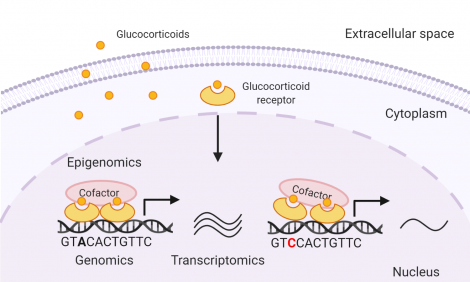Mengyuan Kan
Multi-Omics Analysis Identifies a Novel Glucocorticoid Response-Associated Locus near BIRC3

Presenter
Flash Talk Presenter
I am a postdoctoral researcher in genetics and biomedical informatics. I utilize computational methods and multi-omics data to identify genetic and environmental factors for complex diseases.
Abstract
Rationale: Inhaled corticosteroids (ICS), glucocorticoid drugs commonly used to treat asthma, exert anti-inflammatory effects via modulation of gene transcription following their binding to glucocorticoid receptor (GR) transcription factors. The largest GWAS to date found little evidence that common genetic variants underlie ICS response in asthma patients. We sought to identify nominally significant loci with biological functionality by leveraging evidence from complementary omics datasets.
Methods: 820 GWAS variants nominally associated with ICS response (p-value<10-4) and 3664 variants in high linkage disequilibrium with them were selected. Publicly available GR ChIP-Seq datasets involving three airway cell types and 20 glucocorticoid response-related transcriptomic datasets involving 11 cell types were analyzed with pipelines brocade (https://github.com/HimesGroup/brocade) and RAVED (https://github.com/HimesGroup/raved), respectively. GR-binding sites with glucocorticoid response element (GRE) motifs were identified with the FIMO tool (http://meme-suite.org/tools/fimo). eQTLs were obtained from GTEx v8 datasets of lung and skeletal muscle tissues.
Results: Of 4484 selected variants, 29 were located within GR-binding sites that had significantly increased GR occupancy with glucocorticoid exposure in at least one cell type (q-value<0.05). One locus near the gene BIRC3, a known apoptosis inhibitor, had four GR-binding site-overlapping SNPs within 20kb of BIRC3 transcription start site. These SNPs are BIRC3 eQTLs for lung and/or skeletal muscle tissues, and one was within and one was near putative GRE motifs. BIRC3 also had significantly increased gene expression with glucocorticoid exposure in eight of eleven cell types considered (q-value<0.05).
Conclusion: This nominal significant GWAS locus near BIRC3 should be prioritized for further functional studies of glucocorticoid responses.
Keywords
glucocorticoid response, asthma, multi-omics data integration, transcriptomics, ChIP-Seq, genome-wide association studyCommenting is now closed.
About Us
To understand health and disease today, we need new thinking and novel science —the kind we create when multiple disciplines work together from the ground up. That is why this department has put forward a bold vision in population-health science: a single academic home for biostatistics, epidemiology and informatics.
© 2023 Trustees of the University of Pennsylvania. All rights reserved.. | Disclaimer

